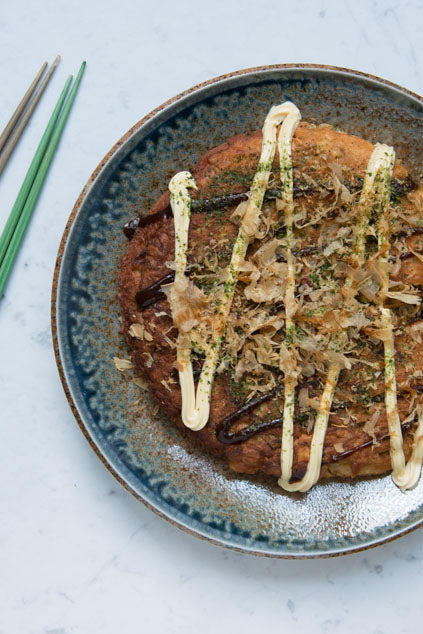
Easy Japanese Okonomiyaki Recipe
-
5 minutes prep time
-
20 minutes cook time
-
Easy

What is okonomiyaki made of?
The classic Japanese okonomiyaki recipe is perhaps the most famous Japanese street food - and rightly so. The crispy pancake outside, moist doughy vegetable-filled interior, sweet-sour sauce topping, and savoury umami-rich garnish, are the ideal foil to a boozy night in town.
Plus it's so packed with vegetables that you'll enjoy 2.5 portions of your 5-a-day servings of fruit and veg!
How do you eat okonomiyaki?
Depending on where is eaten in Japan, both the okonomiyaki recipe and cooking styles are quite different. Hiroshima-style (far South West) layers ingredients directly onto a hot plate where they are mixed, and often include noodles. Whereas Osaka or Kansai-style (central South) mixes together everything in a batter before frying.
What does okonomiyaki mean?
The name okonomiyaki comes from "okonomi" for "what you like" and "yaki" for cooked, and really is interpreted as "anything goes". Okonomiyaki restaurants often serve you the batter and ingredients separately, sitting around a hot plate, so you mix and cook the pancake yourself - quite literally 'cook it how you like it'.
What do you serve with okonomiyaki?
Cabbage is the most popular filling, but pork, squid, savoury mochi (a chewy glutinous rice flour dough) and even Korean kimchi are frequently on the menu. However - certainly in Osaka - the pancake is always identifiable by the criss-cross pattern of mayonnaise and brown okonomiyaki sauces, with ground seaweed and bonito flakes sprinkled across the surface.
The history of okonomiyaki
The history of okonomiyaki is widely disputed, however most agree the current preparation stems from 1930's post-war Japan. The batter and cabbage base made a small number of cheap ingredients go a long way, and the wheat flour base was particularly helpful in a time when rice was scarce.
How to make okonomiyaki
With a little prep time, and under 20 minutes to cook, this Osaka style Japanese okonomiyaki recipe is an ideal mid-week dinner. The cabbage needs to be very finely chopped so that it softens in the pancake, which is most easily done using a mandoline.
Plus, as long as you keep the approximate ratio of vegetables to other ingredients the same, you can use up almost anything lurking in the store-cupboard. From julienned carrots, green beans, grated potato, or rashers of bacon (lay on top of the uncooked batter whilst one side is cooking - they will crisp up and cook through when the pancake is turned over).
Can you use takoyaki flour for okonomiyaki?
Yes, you can make takoyaki and okonomiyaki from the same flour.
Ingredients for okonomiyaki Serves: 2
- 3 tbsp sunflower oil
- 200g chicken breast, finely sliced (optional)
- 140g plain flour
- 175g water
- 5g sachet (1 1/2 tsp) dashi stock granules
- 2 tsp caster sugar
- 1/2 tsp baking powder
- 1/2 tsp Kosher salt
- 2 medium eggs
- 400g finely sliced white cabbage (half a small head of cabbage, trimmed)
- 4 spring onions, sliced on the diagonal
What to serve with okonomoyaki
Method for okonomoyaki
- First cook the chicken, if using. Heat 1 tbsp of oil in a large 28cm frying pan, and stir fry the chicken until cooked through. Remove to a plate and wipe out the pan.
- In a large mixing bowl, whisk together the flour, water, dashi stock, caster sugar, baking powder, salt and eggs until smooth (very small lumps will not matter). Add the cabbage and spring onions, and mix well. The cabbage will have a fine coating of batter.
- Heat the remaining oil in a frying pan over a medium heat. If using chicken, pour in half the cabbage mixture, flatten with a spatula, then evenly arrange the chicken pieces on the surface of the cabbage, and top with the remaining cabbage mixture - making a chicken layer at the centre of the pancake. Otherwise simply add all the cabbage mixture to the pan at once. Press down firmly with a spatula to flatten.
- If you can, cover with a lid to help the pancake cook through - a smaller round heavy lid pressing on the cabbage is best. Cook covered for 7-10 minutes until lightly set, then flip over using a spatula and cook uncovered for a further 7-10 minutes. When cooked the pancake should be piping hot in the centre (around 85°C if using a digital thermometer) - you might need to flip over a couple more times, cooking for a few minutes extra on each side.
- Remove to a serving plate and garnish with mayonnaise, okonomiyaki sauce, aonori seaweed flakes, and katsuo bushi bonito flakes.



